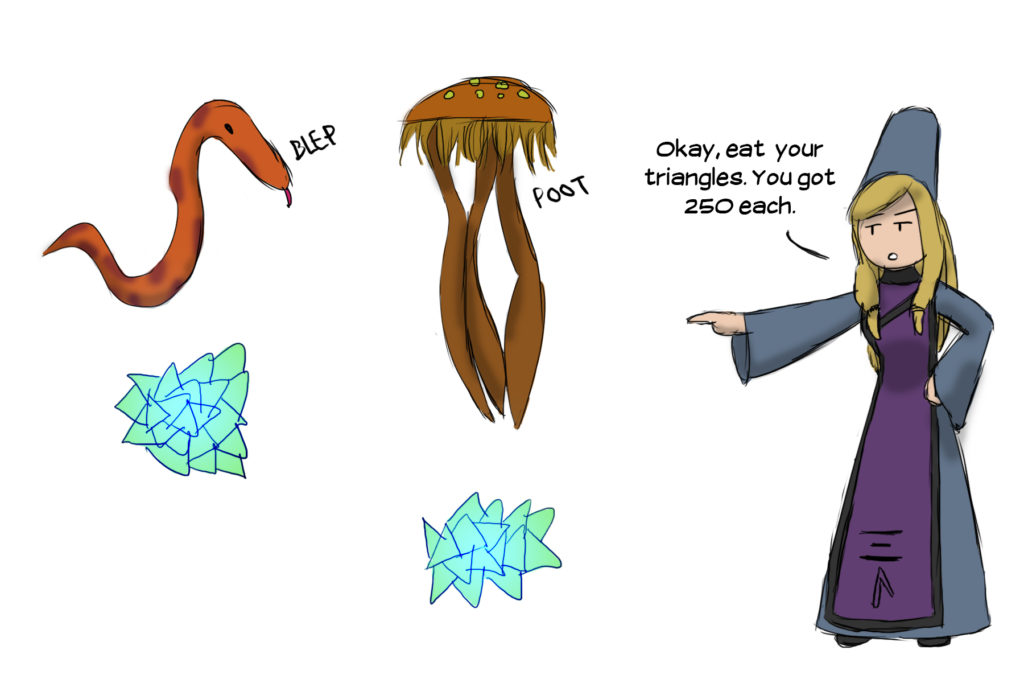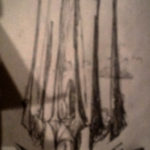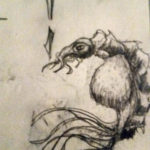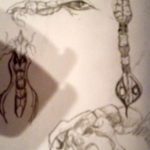In 2001, I was slowly allowed to start buying PC games that I liked with my allowance. The first few titles were stuff available off the Big Lots store shelf, as they were often cheaper. Things like Bugdom and Disney’s Atlantis: Trial by Fire. However, one winter evening near Christmas a game caught my attention. It was a game by the name of Fargate, and it was 50% off in a bargain bin when I had walked in that day. I HAD to get it, considering it looked to be a more complicated game than the “standard” education games I’d play.
It was quite a trip. I had technical difficulties with the game for several years so I never played it past the 4th stage. When I went to college in 2010, I discovered my issues stemmed from the CD being scratched around the rim. I found a cheap replacement copy on eBay and proceeded to beat the game not too far after.

My original manual from 2001, along with the more recently acquired CD case from eBay. I possess the box but was not able to find it for publishing this interview.
When I started to do my interview series, Fargate was one of the games I had an easier time finding people who worked on. In addition to finding such little background information on the game, I felt a proper notation in the interwebs was needed.
I was able to get in touch with two of the guys that worked on it. One of these was Jeff House, one of the artists that worked on the game.
Tell me a bit about yourself. How did you get involved with Super X Studios, then work on Far Gate?
The origin story for Super X Studios and Fargate depends on the person you ask. I was one of three founding members… all of which can point to a single moment where their perspective enters the narrative. The radioactive spider bit me one New Year’s Eve.
Four guys (all of which ended up on the game) at our favorite dive bar at 1am drunk out of our minds. With no women anywhere, the conversation de-evolved to video games and what needed to happen next to create an evolution in gaming. We discussed how they needed to become more theatrical. The plot line had to be both interesting and original. We discussed how it should have a full three dimensions and be able to use them. As we made each point, the eventual leader of the pack would pick his head up from the table (literally by his own hair) and say… “We can do that!”
James Thrush, Dustin Wood, and I were old friends. By coincidence, James was finishing up a contract with Microsoft as a programmer. Dustin had been testing video games and his contract was ending. I was getting out of art school. James proposed the idea. We accepted. Dustin and I started learning 3D Max. I had a ton of Photoshop work from school. The three of us started creating as much content as fast as we could so we would have something to show to a publisher. On the side, I would put together a company’s worth of graphic design (logos, letterhead, business cards, etc…) We had regular meetings to discuss and adjust plot lines, ideas for characters, how we wanted the missions to play out, etc… We called the game ‘The Rift’.
As a focus, we wanted to keep a certain amount of science to the inspiration. I was tasked to create interesting aliens that had a natural reason to survive in space. I visited the zoo and the Seattle Aquarium regularly. I could only have 250 triangles per monster so I tried to be creative with the textures. I took zoomed in photos of all the textures I could form tiger stripes to manhole covers and layered them in Photoshop until I got something organic but cool.
Every so often, either James would add a feature like particle systems, transparency maps, or light maps. I would then spend the next week abusing the feature until I found new and unintentional ways to use it. The original version had only realistic light sources (like the sun) and there was some really cool and creepy effects by making some of the body parts glow or adding running lights to a ship. We had to change it to be more visible. We couldn’t use bones or anything more than a simple animation so I had James create a wave generator for the3D mesh. It would pulse the mesh along an axis to create a subtle breathing action or a wiggle of a tail. I was pretty proud of the results. Our most consistent praise was for the originality and coolness of the graphics. We won the Audience Choice Award at the Independent Games Festival and picked up a Publisher there as well.
We announced about a month or so before Sierra announced their big budget game ‘Homeworld’. They might not have thought of us as rivals but we definitely used them as inspiration to up our game. Soon after we started getting some notice, we were sued over the name and had to change it to Fargate. We made the first build in James’ living room and at least twice we had to go get jobs to support our jobs. We ran out of funding and dissolved by the time our game hit the shelves. We also had the opportunity to put something new and innovative out there. We got to officially release the game in Italy so that was a great trip. One of the best jobs I ever had.
Who was responsible for coming up with Fargate’s story?
We all agreed on a more cinematic/comic book like feel. We wanted a strong Science Fiction base with the illusion of realism. I believe I wrote the original story outline. We all discussed and enhanced it. The depth of everything far exceeded anything we could have possibly put in the game. It would have made a cool novel I think. Individual missions were assigned to whoever was mostly free as long as they followed the outline objectives. I think James created most of the dialogue while I was making special effects and the end cut scene. For an analogy… I would say we all created the bones… I built the muscle structure… the guts, fluids and skin were a collaborative effort.
The cartoon style of the character pictures were a mixture of what I could come up with quickly mixed with what I could remember of the old ‘Star Blazers’ cartoon.
In that line, why did you choose alien “monsters” over an alien race with ships?
We had a few of the human ships designed to get something in the engine. The original plan was to have life forms that could develop in space. A concept sketch of the gullet. (don’t remember what they called it in game but it vomited up missiles) eating a human resource gatherer sold the idea to the group. Seeing Homeworld go the other way solidified it. Besides, the idea was to offer outrageously different ideas than was seen elsewhere.
The Crystalline life forms seemed like a natural way to go too. Something else that could grow in space. we didn’t want to deal with occupied planets. Just outer space. If you follow the original secret plan… the idea was to start an Everquest type MMORPG with mutant Nugs and Humans (possibly Entrodii) on the planet you eventually colonize. Ahh, but for the lack of funding…
Its cool you guys looked up to Homeworld. I’ve been an avid fan of the franchise for over a decade now, and one of the nuts that bought the Mothership statue/Collector’s edition when they re-released the game last year. I think its one of the more solid sci-fi games that’s come out. 😛 I also do recall Star Blazers (Senkan Yamato as my teacher would call it, she was Japanese and a small bit of an anime fan).
What were your design inspirations for the Entrodii and Nue-Guyen? Specifically the Entrodii, who came up with the brilliant idea for living crystals to be in space? (I personally liked it)
We wanted ideas to fit in space. A lot of the inspiration for the Nugs came from sea creatures. I spent a lot of time taking pictures at the Pike Place Market, Seattle Aquarium, and the zoo. I also was lucky enough to spend a year scuba diving in Guam before the project started so I had seen some amazing tropical characters up close.
The idea for the Entrodii came from a mixture of little kid science experiment (dissolve sugar or salt in water and hang a piece of string in it. As water evaporates, the string gains crystals) and an old Star Trek episode where Kirk and Spock meet a silicone based life form. From there, it was a matter of how would living crystals function as a crew.
The total idea was all of us together. The individual ship and base concepts were mine. Dustin took care of the Humans. After he started testing, I made a lot of the special effects. (explosions, weapons and impacts, space anomalies, etc.) It was my first game so I didn’t know what couldn’t be done. The look on James’ face when I asked him if I could attach a tentacle to a ship as a weapon was pretty priceless.
That tentacle thing must’ve been hilarious, though. >:D In fact, this warrants a comic too:
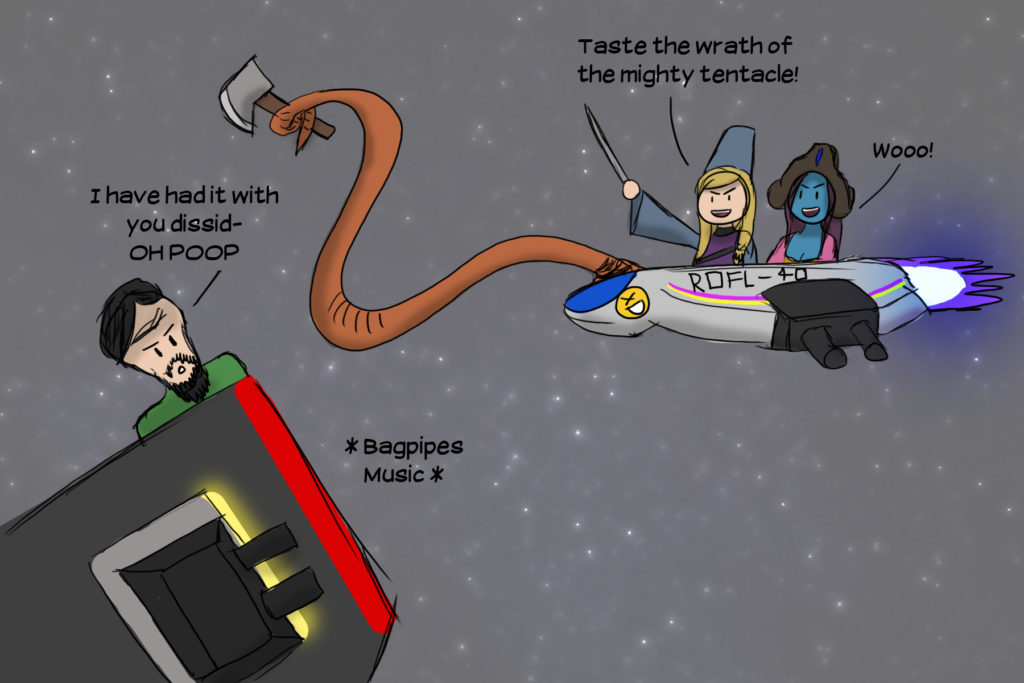
More nonsense from my blog mascots. It wouldn’t have just been the devs that would’ve lost it if ships had tentacles.
My favorite Nue-Guyen units were the Electric Eels and the Octopus/Talon thing. I wasn’t too good with unit balance back in those days, so I would make a heart, spam the Venus Flytrap defense and tow it into harms way with the Tug to chomp down everything. Sometimes effective, sometimes it wasn’t.
What were you using to 3D model?
3D Studio Max (Version 3ish I think). Photoshop for textures and 2D work as well as transparency and light maps. Some custom tools in the engine like particle systems and wave generators. (James awesome tools that I exploited in all the ways possible) I didn’t know anything about 3D Max when we started so after I learned a few tricks, Everything would be tweaked and updated. For extremely low poly models… I thought they worked great.
I designed nearly half of the Entrodii ships when Titan AE came out with it’s first preview in the movie theaters. The bad guys in that movie were made of energy but the ship that blows up the Earth looked almost exactly like my first version of the Entrodii battlecruiser.
Did you ever finish the game?
I did finish it! It’s awhile back (December 31, 2010), but I remember it took a long while because of that black hole in the center of the map. I actually found a picture my brother took when I was attempting to do it; I was at home during winter break from college, and had taken my laptop and wired it up to the HD TV. You can actually see that the cutscene for the last mission is on the screen!

Just before starting the last mission in Far Gate. Penne rigate was on the menu that day. Shot taken on December 31st, 2010.
In the mission that Jacob goes back to Earth, its mentioned that he used to be part of a resistance group called Ka-Ge. Did that name have any origins or any specific meaning?
There was way too much content for the amount of time we had to build the game and that part of the story arc was edited out. Firefly wasn’t around at the time but Malcom Reynolds would have been the original idea for his character. The Ka-Ge were a band of pirates, smugglers, and rebels. I don’t remember what the name means but we did decide that the universal common language was a mix of Chinese and English. (a.k.a Blade Runner) I think Dustin named them and I want to say it means the claw…but that’s many years ago.
One of the ideas was to spin off many games in the same universe. I remember making some missions where you had to do a job for the Ka-Ge but they may have been cut. There was a spin off game possible too.
What do you do now that you don’t work at a game studio?
The economy crashed and we ran out of money. We all went separate ways. By the time James had Wild Earth going, we all started other things. The industry moved to high poly models and most of the companies weren’t hiring much. I spent the next 15 years as a ballroom dance teacher and professional competitor. I was injured and lost most my clients.
Now I am a mailman. Steady pay, decent benefits. I considered getting back into the industry, but companies tend to swing from…we’ll teach you the software to we want tons of experience. You have to be unemployed at the right time…ha!
Working with a small gaming studio back in the day, how do you think it compares to people who do startups to make games now? Do you think the process is easier or harder? What’s your general view of the indie game market?
I think the tools are there to make it easier. Internet commerce has changed a ton. You can distribute a game with a reasonable download and keep more in your pocket. A small team could do what we did the hard way. I see some amazing innovative products and lots of clones of clicky games.
As you’ve seen the gaming industry change in the time since you’ve worked on Fargate, do you have any insights of where things might go? Do you do any gaming yourself?
I think they are headed where I originally hoped… Basically interactive movies. With the augmented reality ideas… I can see people playing games through their sunglasses. I occasionally get onto dungeons and dragon online. I used to be a big Everquest fan. I have a handful of games for the Xbox I play on days off. Otherwise dancing messed up my video games addiction. Now I want to move too much.
Favorite book, movie and food?
Dresden Files (ok that’s a lot of books), Reign of Fire, and a fat ribeye steak.
Is there anything else you feel relevant that you want to add?
The game was a great project. I wish we could have done all the other projects. Alas… one must pay rent.
–
Along with our correspondence, Jeff also gave me a few shots of the concept art from the Nue-Guyens. Extremely interesting stuff!
- Concept for an Entrodii ship.
- Cudgel (jellyfish thing) and Blood Worm unit concepts.
- Worker drone concept
- Eel unit concept
- Concept for the endgame creature, which helps terraform Vesta
–
Jeff does dabble in writing now and then, specifically of the fantasy genre. If I ever hear more, I’ll definitely let you guys know about anything special.
Thanks so much for letting me get the chance to interview you, and sharing your experience on creating an interesting game from when I was younger! Until next time.

